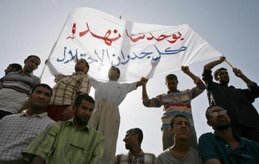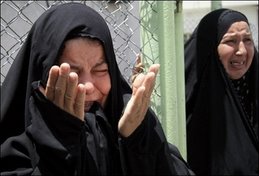U.S. Boosts Its Use of Airstrikes In Iraq
Strategy Supports Troop Increase
By Josh WhiteWashington Post Staff WriterThursday, January 17, 2008; A01
The U.S. military conducted more than five times as many airstrikes in Iraq last year as it did in 2006, targeting al-Qaeda safe houses, insurgent bombmaking facilities and weapons stockpiles in an aggressive strategy aimed at supporting the U.S. troop increase by overwhelming enemies with air power.
Top commanders said that better intelligence-gathering allows them to identify and hit extremist strongholds with bombs and missiles, and they predicted that extensive airstrikes will continue this year as the United States seeks to flush insurgents out of havens in and around Baghdad and to the north in Diyala province.
The U.S.-led coalition dropped 1,447 bombs on Iraq last year, an average of nearly four a day, compared with 229 bombs, or about four each week, in 2006.
"The core reason why we see the increase in strikes is the offensive strategy taken by General [David H.] Petraeus," said Air Force Col. Gary Crowder, commander of the 609th Combined Air Operations Center in Southwest Asia. Because the United States has sent more troops into areas rife with insurgent activity, he said, "we integrated more airstrikes into those operations."
The greater reliance on air power has raised concerns from human rights groups, which say that 500-pound and 2,000-pound munitions threaten civilians, especially when dropped in residential neighborhoods where insurgents mix with the population. The military assures that the precision attacks are designed to minimize civilian casualties -- particularly as Petraeus's counterinsurgency strategy emphasizes moving more troops into local communities and winning over the Iraqi population -- but rights groups say bombings carry an especially high risk.
"The Iraqi population remains at risk of harm during these operations," said Eliane Nabaa, a spokeswoman for the U.N. Assistance Mission for Iraq. "The presence of individual combatants among a great number of civilians does not alter the civilian character of an area."
UNAMI estimates that more than 200 civilian deaths resulted from U.S. airstrikes in Iraq from the beginning of April to the end of last year, when U.S. forces began to significantly increase the strikes to coordinate with the expansion of ground troops.
The strategy was evident last week, as U.S. forces launched airstrikes across Iraq as part of Operation Phantom Phoenix. On Thursday morning in Arab Jabour, southeast of Baghdad, the U.S. military dropped 38 bombs with 40,000 pounds of explosives in 10 minutes, one of the largest strikes since the 2003 invasion. U.S. forces north of Baghdad employed bombs totaling more than 16,500 pounds over just a few days last week, according to officers there.
"The purpose of these particular strikes was to shape the battlefield and take out known threats before our ground troops move in," Army Col. Terry Ferrell, commander of the 2nd Brigade, 3rd Infantry Division, said at a news conference in Baghdad last Friday, describing the Arab Jabour attacks. "Our aim was to neutralize any advantage the enemy could claim with the use of IEDs and other weapons," he said, referring to improvised explosive devices.
Counterinsurgency experts said the greater use of airstrikes meshes with U.S. strategy, which calls for coalition troops to clear hostile areas before holding and then rebuilding them. U.S. forces have put the new counterinsurgency efforts into play by using their increased numbers to home in on insurgent strongholds.
Colin Kahl, a professor of security studies at Georgetown University who studies the Iraq war, said airstrikes rose in 2007 because of a combination of increased U.S. operations and a realization that air power can have a strong psychological effect on the enemy.
"Part of this is announcing our presence to the adversary," said Kahl, who recently returned from a trip to the air operations center. "Across this calendar year you will see a reduction in U.S. forces, so there will be fewer troops to support Iraqi forces. One would expect a continued level of airstrikes because of offensive operations, and as U.S. forces begin to draw down you may see even more airstrikes."
Senior Air Force officials said the greater use of airstrikes stems from better intelligence that provides a clearer picture of the battlefield. Commanders said the additional U.S. forces in Iraq over the past year have pushed insurgents out of urban areas and into places that are easier to target.
"You see an increase in the number of kinetic strikes because we have found the enemy, we are finding the enemy's emplacement sites, manufacturing facilities for IEDs and caches of weapons," said Air Force Lt. Gen. Gary L. North, the U.S. Central Air Forces and Combined Forces Air Component commander. "And we're striking them."
The Marine Corps keeps its own statistics for airstrikes in western Iraq but could not provide 2007 data.
In Afghanistan, where U.S. and NATO bombings picked up in the middle of 2006, coalition airstrikes reached 3,572 last year, more than double the total for 2006 and more than 20 times the number in 2005. Many of the strikes have targeted the Taliban and other extremists in Helmand province, and military officials said they have been able to use air power to support small Special Forces units that engage the enemy in remote locations.
Human rights groups estimate that Afghan civilian casualties caused by airstrikes tripled to more than 300 in 2007, fueling fears that such aggressive bombardment could be catastrophic for the innocent.
Marc Garlasco, a military analyst at Human Rights Watch who tracks airstrikes in Iraq and Afghanistan, said the strikes carry unique risks. "My major concern with what's going on in Iraq is massive population density," he said. "You have the potential for very high civilian casualties, so you need really granular intelligence on what you're going to hit. But I don't think they're being careless."
In preparation for last week's major airstrikes near Baghdad, North said, he met two weeks ago with Army Maj. Gen. Rick Lynch, commander of the 3rd Infantry Division and U.S. forces in Baghdad, to walk through the plans.
"What you're seeing in the last few days is a very deliberate process honed by intelligence, targeted and aligned to get the desired effect in a particular area," North said.
Commanders also said they are using air power more creatively, in some cases dropping bombs that explode in the air to detonate insurgent roadside bombs. Other U.S. munitions have cut off small bridges or roads to isolate insurgent movement. As seen in Air Force videos, some attacks have been extremely precise, such as when a Predator unmanned aircraft fired an AGM-114P
Hellfire missile to kill three extremists who were setting up a mortar attack on Nov. 7 in Balad.
North said the Air Force has used concrete-filled bombs to detonate IED sites and is using 250-pound GBU-39 small-diameter bombs to make blasts safer for civilians. Commanders also have been using airstrikes on houses suspected to be rigged with explosives, called "house-borne IEDs."
Such a strike occurred Jan. 6, when soldiers with the 2nd Battalion, 1st Cavalry Regiment, 4th Stryker Brigade Combat Team spotted five suspected insurgents with rocket-propelled grenades and AK-47 rifles apparently rigging a house with explosives near Khan Bani Saad, northeast of Baghdad. Lt. Col. Stuart Pettis, air liaison officer for Multinational Division North, said the unit asked for airstrikes.
"After doing a show of force to get civilians out of the area, they engaged the house and the fighters with a 500-pound bomb," he said of the attack by two British Tornado GR4 jets. "They took the fighters out."









